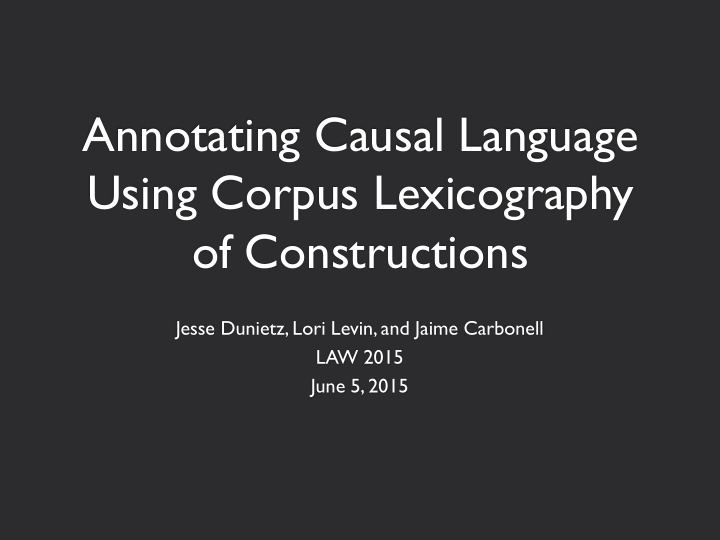



Annotating Causal Language Using Corpus Lexicography of Constructions Jesse Dunietz, Lori Levin, and Jaime Carbonell LAW 2015 June 5, 2015
Contributions of this paper Raising issues about corpus annotation: Low agreement among non-experts Methodology for annotation projects Lexicon driven annotation: as in PropBank and FrameNet An annotation scheme for causal language in English A constructicon of causal language in English A small annotated corpus of causal language in English All still in progress
Causal relations would be useful to annotate well… Ubiquitous in our mental models Medical symptoms Political events Interpersonal actions Ubiquitous in language 2 nd most common relation between verbs Useful for downstream applications (e.g., information extraction) The prevention of FOXP3 expression was not caused by interferences.
…but annotating them raises difficult annotation issues. causes because of For reasons of forbid to convinced to too to If After Don’t because of
1. A detailed, construction- based representation
Several projects have attempted to annotate real-world causality . SemEval 2007 Task 4 flu virus Richer Event Descriptions B EFORE - PRECONDITIONS allocated equipped O VERLAP - CAUSE ill need
Others have focused on causal language . Penn Discourse Treebank … … Causality in TempEval-3 acquired as a result of agreement BEFORE CAUSE BioCause
Causal language: a clause or phrase in which one event, state, action, or entity is explicitly presented as promoting or hindering another
Connective: fixed construction indicating a causal relationship because prevented from causes Not “truly” because causal
Effect: presented as outcome/inferred conclusion Cause: presented as producing/indicating effect John killed the dog it was threatening his chickens John the dog eating his chickens Ice cream consumption drowning She must have met him before she recognized him yesterday
We exclude language that does not encode pure, explicit causation :
Four types of causation because of C ONSEQUENCE because M OTIVATION in order to P URPOSE so I NFERENCE
Not all causal relationships are of equal strength or polarity. E NTAIL caused F ACILITATE Only by can E NABLE Without D ISENTAIL kept from I NHIBIT P REVENT
2. Comparison of two annotation approaches
First Try • Dunietz and three annotators (A1, A2, A3) • A1, A2, and A3 are recently graduated linguistics majors. • A1 had more than one year annotation experience. • A2 and A3 did not have annotation experience.
First try (Continued) • Rounds of annotation and reconciliation • Produced a coding manual • Annotator A4 • Masters in linguistics plus 30 years experience with corpus annotation and NLP
Annotators determined the causation type using a decision tree. choose feel think temporally follow the cause more/less likely fact about the world outcome more or less he/she hopes to achieve strongly Purpose Motivation Disentail Inhibit
Annotators determined the causation degree using another decision tree. increasing decreasing Facilitate Inhibit
Annotators found a more fine-grained decision tree too difficult to apply. increasing decreasing significantly significantly merely merely Facilitate Enable Disentail Inhibit
We have annotated a small corpus with this scheme. Total 93 3333 845
We computed intercoder agreement between Dunietz and A4 after 3 weeks of training. 201 sentences from randomly Causation types: selected documents in the NYT subcorpus
Initial agreement between Dunietz and A4 was just moderate for connectives, and abysmal for causation types. F 1 κ κ F 1 κ ) Very unhappy annotators!
T o eliminate difficult, repetitious decision-making, we compiled a “ constructicon .” • Constructicon: • Fillmore, Lee-Goldman, and Rhodes, 2012 • Lee-Goldman and Petruck, ms. Our English causal language constructicon: • 79 lexical head words • • 166 construction types Counting prevent and prevent from as the • same lexical head word but different constructions.
Connective <cause> prevents <enough cause> for pattern <effect> from <effect> to <effect> <effect>
Additional examples from the causal language constructicon For <effect> to <effect>, <cause> As a result, <effect> Enough <cause> to <effect> <effect> on grounds of <cause> <cause> is the reason to <effect> <effect> results from <cause>
Dunietz and a new annotator, A5, annotated a similarly-sized dataset using the constructicon. < 1 day of training 260 sentences: annotated by Dunietz and A5 Causation types: A5 has a masters degree in language technologies and had no prior annotation experience.
Constructicon-based annotation improved results dramatically. F 1 κ κ F 1 κ ) Annotators reported no difficulty!
Lexicography helps when, without it, annotators must make the same decisions repeatedly
3. Broader implications of low non-expert agreement
Expertise Baseball players use physics, but they don’t have to know physics. What can we expect from people who speak languages but are not trained in metalinguistic awareness? When they have trouble with our annotation schemes, we start to worry. Is it something real that only experts are aware of? Are we, the experts, just making things up?
What lends validity to an annotation scheme? Riezler (2014) Reproducibility by non-experts Improvement of an independent task Chomsky’s notion of explanatory adequacy and predictive power This annotation scheme will be validated by independent task
Thank you for listening
Recommend
More recommend